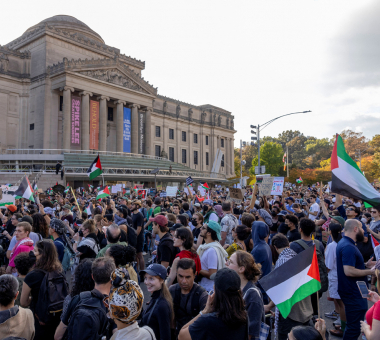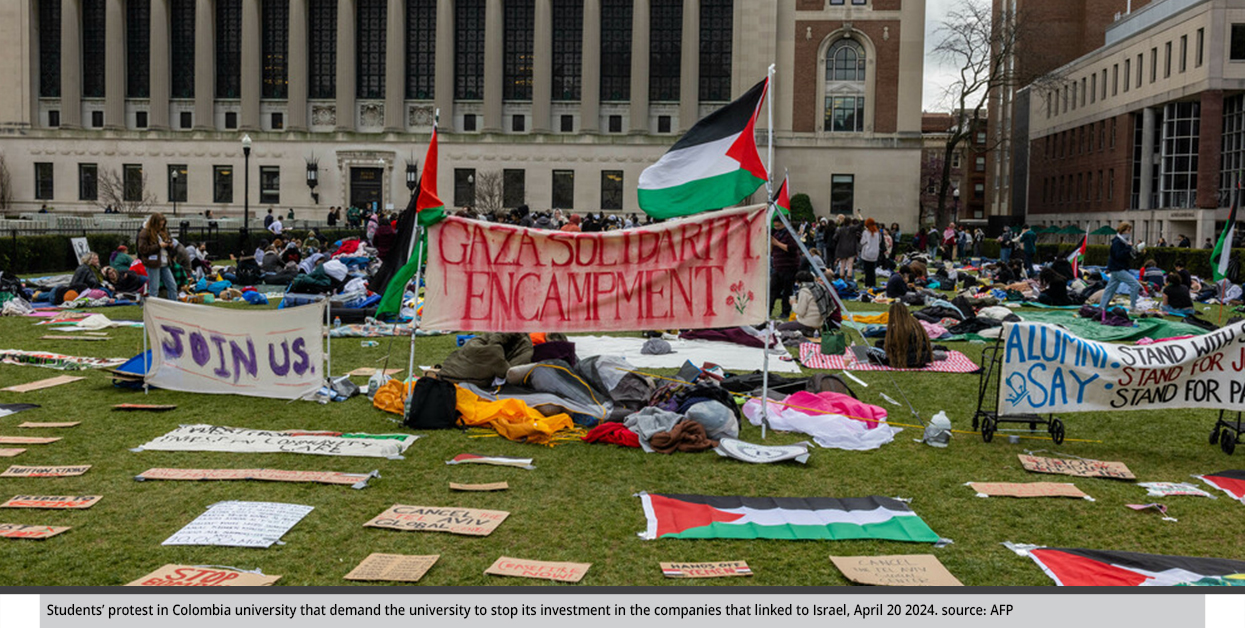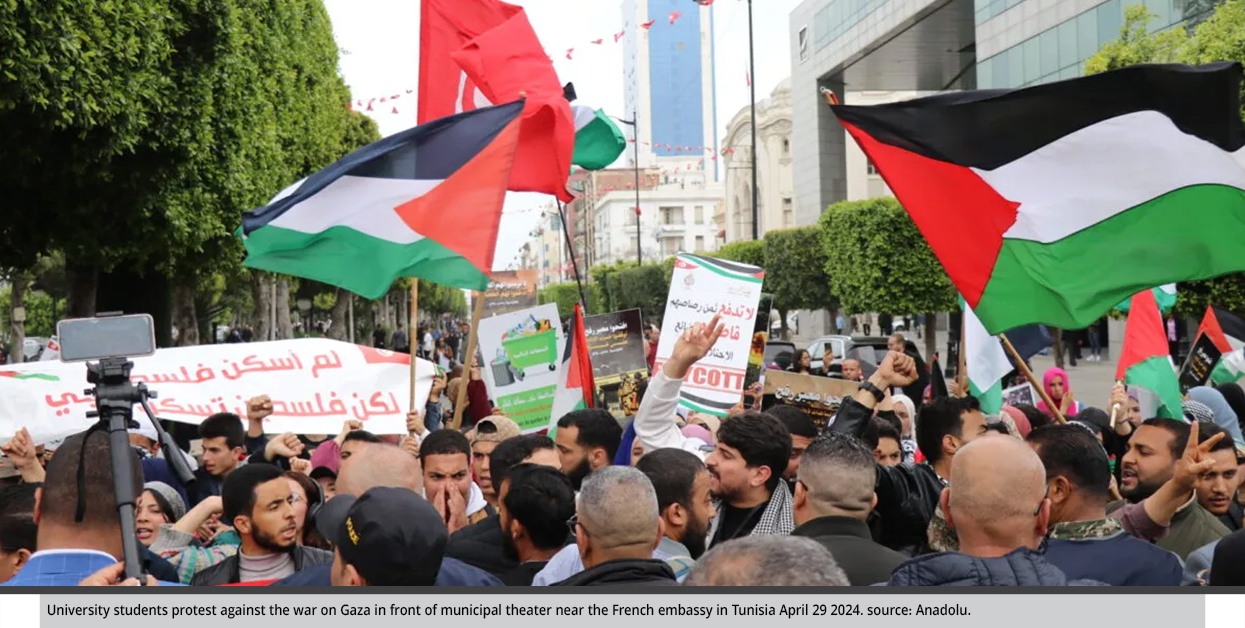How Will the American University Protests Impact the Course of the Israeli War in Gaza?
With the widespread student protests across American and western universities demanding a ceasefire in Gaza, is a new relationship forming between the upcoming Alpha Generation and Israel? And will it have a snowball effect that spreads to Arab and Palestinian universities?
by STRATEGIECS Team
- Release Date – May 1, 2024

The campus protest in many American universities this spring drew world attention, particularly in the analysis and interpretation of this movement within academic institutions known for their elite and capitalist structure, which made the protests hard to overlook or dismiss, especially when many of these elite universities restored to local law enforcement authorities dispersing or arresting the students and protestors. The ultimate question is if these collective protests will have a far-reaching impact on the war in Gaza.
Factors Driving the American Campus Protest
The war in the Gaza Strip, along with the high numbers of civilian casualties and unprecedented humanitarian suffering it caused in the region, has globally shifted official and public stances towards the Palestinian cause. This began with popular protests in countries worldwide and escalated to become a primary focus among the youth, who are considered a driving force for public opinion at both local and international levels. To understand the effects of this movement, one can look back to the massive 1968 student protests in France protesting the American war in Vietnam. These protests quickly spread worldwide, leaving a strong impression on how youth protests evolved into a global collective phenomenon often aligned with humanitarian and rights-based convictions.
The current student protest movement in American universities came as a surprise due to the Israeli influence in American decision-making centers and the particularity close U.S.-Israeli relations at both official and popular levels, as well as the relationships between American universities and major companies linked to Israel. The interpretation of this movement is tied to a series of intertwined factors.
1- The unprecedented and staggering human cost of the ongoing war on Gaza, with close to 35,000 Palestinian civilians killed—more than 14,000 children and 10,000 women, including an estimated 6,000 mothers, leaving 19,000 children orphaned—in addition to the massive destruction of Gaza’s infrastructure. There are also global concerns about an imminent famine under Israeli-made blockades and obstacles hindering the delivery of food and humanitarian aid. The UN estimates that more than 1 million Palestinian women and girls in Gaza are facing catastrophic hunger, with almost no access to food, safe drinking water, functioning toilets or running water.
2- There is a generation gap in America regarding viewpoints towards Israelis and Palestinians, highlighted by a survey conducted by the Pew Research Center in March 2023. The pre-war poll revealed a sharp disparity between the youth and the elderly. Sixty percent of Americans under 30 held a favorable view of the Palestinian people, whereas 76% of those aged 65 or older held a favorable views of Israelis.
Additionally, results from a nationwide online poll conducted by Harvard CAPS/Harris Poll on December 13–14, 2023, revealed that only 50% of Americans aged 18–24 support Israel over Hamas, and 42% of that age group support Hamas remaining in power.
3- Internal shifts within the Democratic Party led by the leftist faction reject the pro-Israeli policies of the Biden administration, which it believes is in violation of American laws. This was articulated by Democratic Senator Bernie Sanders, a Jew, who emphatically stated on CNN, April 10, 2024, that U.S. policy should be: “Not another nickel for Netanyahu’s right-wing extremist government while hundreds of thousands of [Palestinian] people in Gaza face starvation. Period! … Not another nickel until Netanyahu changes his entire policy [regarding Gaza.]”
4- The war served as a catalyst for the participation of American communities and minorities (African, Arab, Islamic, Latino, and Asian) and contributed significantly to daily protests in American cities. Students from these communities are considered a major part of the protests within the campuses of many American universities.

5- The effects of new media tools, social media, and live broadcasting, both in terms of broadcasting war scenes in Gaza around the clock and challenging the diversity of opinions and perspectives to the traditional Israeli narrative that dominated traditional media channels.
6- The intervention of police forces at Columbia University exacerbated the anger of students, leading human rights organizations to intervene in the crisis, as well as an expansion of protests beyond the campuses in the United States.
Future Effects of the Campus Protest
The momentum gained by student movements in American universities and its broadening scope despite periods of interruption entails a series of short-term and long-term effects. Some of them relate to the position of the U.S. administration on the war in Gaza.
Short-Term Effects
1- There is concern within Israeli government over the impact of the protests on the Biden administration’s support in the war. On March 25, Israeli Defense Minister Yoav Gallant wrote online that the protests “are not only antisemitic, but also inciting terrorism.” Five hours later that same day, Netanyahu declared online: “What’s happening in American campuses is horrific. Antisemitic mobs have taken over leading universities. They call for the annihilation of Israel. They attack Jewish students. They attack Jewish faculty members. This is reminiscent of what happened in German universities in the 1930s.”
2- The shifts in the American public’s opinion toward the war in Gaza led the Biden administration to change its stance against a ceasefire and intensify its pressure on the Israeli government to allow more humanitarian aid to enter Gaza. This comes alongside repeated calls from American officials for Israel to not invade Rafah and cease unilateral fighting.
3- The escalating protests and ineffectiveness of the police in stopping them prompted some university administrations to offer concessions to protesting students regarding the universities’ relations with Israel and their stances on the war. For example, Brown University made an agreement with the protesting student that it will review its relations with companies linked with Israel in exchange of removing the protest tents from campus.
4- The pro-Palestinian protests on American campuses quickly spread to prestigious universities in Canada, France, the United Kingdom, Germany, Australia, Norway, Spain, the Netherlands, Belgium, Finland, Brazil, Switzerland, and Japan. Indeed, an ever-growing number of universities worldwide have already suspended or are now reviewing their financial and professional relationships with Israel.
5- The student movement has spread to some Arab universities. Students have protested in the American University in Cairo, as well as many Moroccan and Tunisian universities. Meanwhile, universities organized a general strike on the same date.

Long-Term Effects
Below is a four-point summary of the long-term effects of the student protests, including a seismic shift in American and Western interest in the Palestinian cause and the necessity of reaching a just solution, as well the impact on Western-Israeli relations and ideological and partisan trends in Western countries.
1- The protests quickly rose from the streets to the elites. What started as casual protests soon engulfed every one of the nine American Ivy League universities that have produced generations of political and economic leaders both in the United States and abroad: Columbia, Harvard, Yale, Princeton, Pennsylvania, Brown, Stanford, Dartmouth, and Cornell.
2- The Palestinian issue has returned to its original position as an international humanitarian cause that transcends sectarianism, nationalities, and political exploitation by regional powers in service to their national and sectarian interests. This gives the issue significant momentum and contributes to uncovering the veil over efforts to manipulate it or exploit it by specific entities.
3- The American university movement will have profound future effects on the orientation and direction of Western leftist and democratic parties. This will involve compelling them to adopt new political agendas that seek to uphold the rights of the Palestinian people. This transformation is likely to be most pronounced in countries with highly active party politics, such as France, Italy, Germany, and Spain, and it will impact their foreign policies related to the Israeli-Palestinian conflict.
4- Student protests continue in Western and American universities despite escalating repression that is turning some of these campuses into military barracks, a scene entirely unfamiliar in Western societies.
This fourth effect raises the possibilities that these protests may evolve, increasing in strength and impact worldwide until it becomes one of the most effective tools in stopping the war. Moreover, and perhaps more importantly, it also indicates a broader transformation in the stances of Westerners towards humanitarian issues in the third world, which have all too often been absent from their spheres of interest. Hopefully, this will keep the Palestinian issue a subject of continued scrutiny and concern for decades after this war ends.

STRATEGIECS Team
Policy Analysis Team
 العربية
العربية